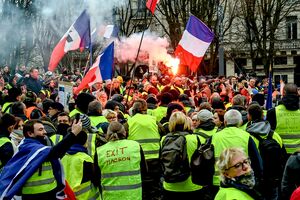Yellow vests protests

Relevance
Image used as a backdrop during "I'm Throwing My Arms Around Paris" circa 2019 and again in 2023.
-
screenshot from video source - marcelonic1 / YouTube
Wikipedia Information
 |
The yellow vests protests or yellow-jacket protests (French: Mouvement des gilets jaunes, pronounced [muvmɑ̃ de ʒilɛ ʒon]) were a series of populist, grassroots weekly protests in France that began on 17 November 2018 and ended on 28 June 2020. Some minor protests started again after the restrictions linked to COVID-19 were lifted. After an online petition posted in May 2018 had attracted nearly one million signatures, mass demonstrations began on 17 November. The movement was initially motivated by rising crude oil and fuel prices, a high cost of living, and economic inequality. The movement argued that a disproportionate burden of taxation in France was falling on the working and middle classes, especially in rural and peri-urban areas. The protesters called for lower fuel taxes, a reintroduction of the solidarity tax on wealth, a minimum wage increase, among other things. On 29 November 2018, a list of 42 demands was made public and went viral on social media, becoming a de facto structuring basis for the movement. The demands covered a wide range of topics, mostly related to democracy, and social and fiscal justice. Some demanded the resignation of President Emmanuel Macron. Participation in the weekly protests diminished due to violence, particularly due to the loss of eyes, hands, and neurological disorders caused by police blast balls. The protests eventually stopped due to the COVID-19 pandemic in France but continued again after health restrictions were lifted. The movement was supported primarily by populists on both sides of the political spectrum, but rarely by moderates. According to one poll, few of those protesting had voted for Macron in the 2017 presidential election; many had shown political alienation by not voting, or had voted for far-right or far-left candidates. Support for the movement reached a high of 75% in favour at its beginning, with even higher numbers in rural and peri-urban areas. Yellow high-visibility vests, which French law requires all drivers to have in their vehicles and to wear outside their vehicle during emergency situations, were chosen as "a unifying thread and call to arms" because of their convenience, visibility, ubiquity, and association with working-class industries. The protests have involved demonstrations and the blocking of roads and fuel depots, sometimes developing into major riots, described as the most violent since those of May 68. The police action, resulting in multiple incidents of loss of limb, has been criticised by politicians and international media; it has sometimes resulted in police officers being charged for their violent behaviour. The movement has received international attention. Protesters in many places around the world have used the yellow vest as a symbol. About 3 million people have participated in the yellow vests movement.

